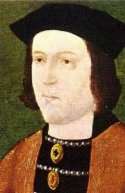Edward was born in 1442, at Rouen in France, the eldest son of Richard, Duke of York, a leading claimant to the throne of England. York's challenge to the ruling family marked the beginning of the conflict known as the Wars of the Roses. When Richard was killed in 1460, at the Battle of Wakefield, pressing his claim against the Lancastrian king, Henry VI of England, Edward became his heir.
With the support of Richard Neville, Earl of Warwick ("The Kingmaker"), Edward, already showing great promise as a leader of men, defeated the Lancastrians in a succession of battles. While Henry and his militant queen, Margaret of Anjou, were campaigning in the north, Warwick gained control of the capital and had Edward declared king in London in 1461. Edward strengthened his claim with a decisive victory at the Battle of Towton in the same year, in the course of which the Lancastrian army was virtually wiped out.
Edward was tall, strong, handsome, and popular (and his grandson Henry VIII of England was much like him in these qualities). Warwick, believing that he could continue to rule through him, pressed him to enter into a marital alliance with a major European power. Edward, who had appeared to go along with the wishes of his mentor, then alienated Warwick by secretly marrying a widow, Elizabeth Woodville (having previously married the widow Eleanor Talbot even more secretly). The Woodville family became powerful at Warwick's expense. The Earl changed sides and led an army against Edward, on behalf of the former king, Henry, who was mentally unstable and had been imprisoned for several years. With Elizabeth, Edward would eventually have three sons and seven daughters (not all of whom lived to adulthood). He also had numerous mistresses; the one best known to historians is Jane Shore.
Henry VI was briefly restored to the throne, and Edward escaped to France, where he raised an army to win back his kingdom. Philippe de Commines spent time with Edward while he was the guest of Commines's master the king of France in 1470-1471. Later Commines said of King Edward:
- "He had been during the last twelve years more accustomed to his ease and pleasure than any other prince who lived in his time. He had nothing in his thoughts but les dames, and of them more than was reasonable; and hunting-matches, good eating, and great care of his person. . . [I]t is not surprising that his person was as jolly as any one I ever saw. He was then young, and as handsome as any man of his age; but he has since become enormously fat."
Commines explained that it was how much Edward owed them that had made Londoners eager to put him back on the throne, along with the fact that he was very popular with the women of that city, and they so nagged their husbands that the menfolk welcomed Edward back just "for the tranquility of their lives."
Edward died suddenly in 1483 and is buried in Windsor Castle. He was succeeded by his twelve-year-old son, Edward V of England. Although his son was quickly barred from the throne and succeeded by Richard of Gloucester, Edward IV's daughter, Elizabeth of York, later became the queen of Henry VII of England.
Was Edward illegitimate?
Questions about the paternity of Edward IV had been raised by Richard Neville, Earl of Warwick in 1469 and repeated by George, Duke of Clarence shortly before his death in 1478, but with no evidence. Parliament seems to have addressed this rumour in Titulus Regius (the text of which is believed to come word-for-word from the petition presented by Buckingham to the assembly which met on June 25, 1483, to decide on the future of the monarchy). It describes Edward's brother Richard III as "the undoubted son and heir" of Richard, Duke of York and "born in this land" -- an oblique reference to his brother's birth at Rouen and baptism in circumstances which could have been considered questionable. Dominic Mancini says that Cecily Neville, King Edward's and King Richard's mother, was herself the basis for the story: When she found out about Edward's marriage to Elizabeth Woodville, in 1464, "Proud Cis" flew into a rage. One of the things she said then was that she was of a good mind to declare he was illegitimate and so have him kicked off the throne for his foolishness.As historical novelist Sharon Kay Penman explains, paid propagandists
for Henry Tudor, after he became Henry VII (and King Richard was dead),
concocted out of whole cloth the story that Richard III had said his brother
Edward was illegitimate: "Tudor's official historian, Polydore Vergil,
. . . contend[ed] that Richard based his claim to the crown upon his brother
Edward's illegitimacy. This was, of course, an out-and-out lie."
| Preceded by:
Henry VI |
List of British Monarchs | Succeeded by:
(Edward V) |
